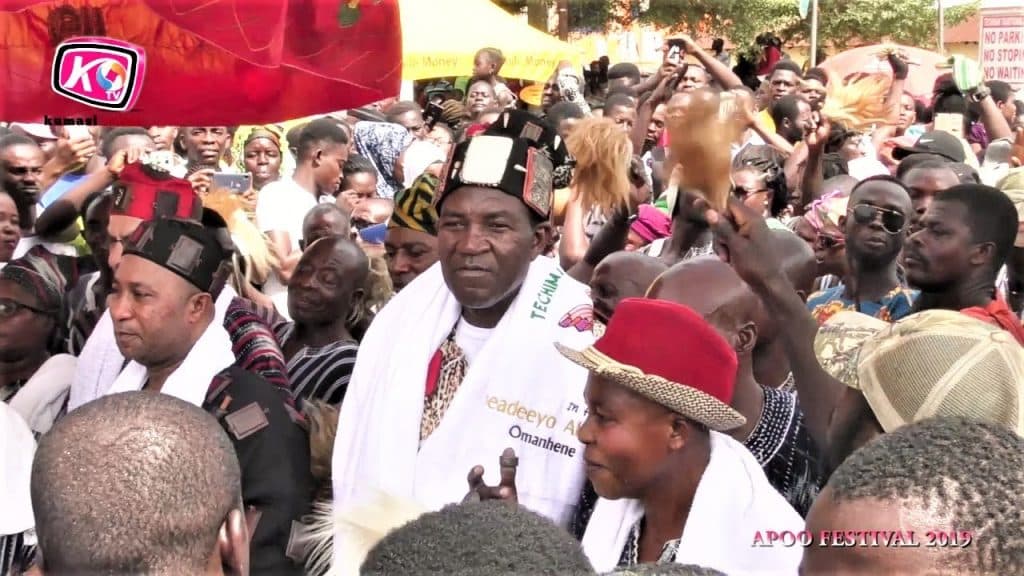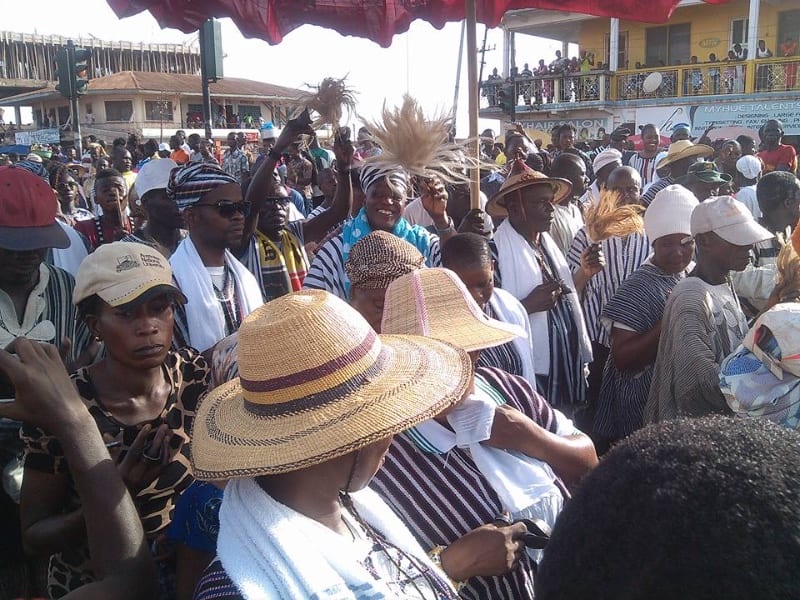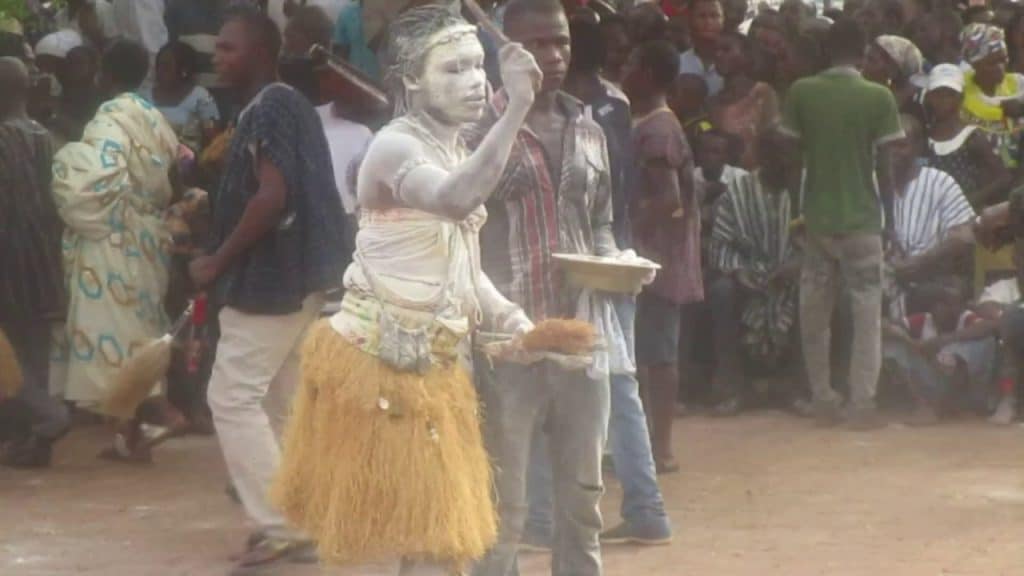The Apoo Festival is an annual festival held in Western Ghana (specifically in the towns of Techiman and Wenchi) that lasts a week in March and April. The festival is intended to ritually cleanse the people of social evils while also uniting people and families through a variety of other traditional cultural activities. The word ‘apoo’ is derived from the root word ‘po,’ which means ‘to reject.’
The festival is strongly associated with the Bono movement. Not only is it held in Techiman, one of the most important cities to the Bono people and kingdom, but during the titular Apoo procession, insults, proverbs, maxims, songs, and historical recountings of the Bono Kingdom are exchanged; many of these insults, proverbs, and songs are directed towards the Ashanti, who conquered the Bono Empire.

History
According to oral tradition, the festival began during the reign of Nana Kwakye Ameyaw, an authoritarian ruler who prevented the people of Techniman from freely expressing their opinions. They consulted the local gods because they couldn’t hold the authorities accountable. They were asked to set aside some of their days to express their feelings, particularly toward the authorities. During this time, it was agreed that no one, regardless of status, could be held accountable for what they said. People would say, “Mereko po me haw,” which literally meant, “I’m going to say what’s on my chest,” and thus the “Apoo” festival was born.
Traditions
It is believed that by airing grievances and grudges, people and their souls are ritually cleansed of evil. Women will clean their homes, utensils, and roads in preparation for the Apoo festival, and this purification to prevent such evils from returning. Before the festival, priests in the area will parade through the streets to spiritually destroy malicious charms hidden by evil spirits; this process is known as ‘Nnusin-tuo.’
‘Hyereko,’ which literally means ‘the collection of white clay,’ is another important preliminary tradition. Women collect white clay from the Aponkosu River and use it to decorate the local shrines before the Apoo festival begins. When being possessed by/communing with spirits, priests, and priestesses will also use clay on their bodies.
Drums are beaten to signal the start of the festival. The Paramount Chief, village elders, secondary chiefs, and court lead the Apoo procession. During the ‘Apoo’ procession, grievances are expressed and insinuations about the wrongdoings of others are made. Even the chief is not immune to this slander. During this time, people are encouraged to settle family feuds, and it is a time for reconciliation.
The procession goes to the grave of the last Bonohene, the traditional leader of the Bono people, early in the festival. The village elders and the Paramount Chief gather around the grave as the Chief offers up sheep and pours libations. The remainder of the procession stays outside until the rites are finished. The Royal Graveyard’s custodian, the ‘banmuhene,’ prepares a dish of oiled, mashed-up yam seasoned with ‘eto’ condiments, which is then offered to the ancestral spirits. The secondary chiefs pour more libations on the stools placed on the grave, while the banmuhene requests prosperity and peace from the ancestral spirits. The sheep is then slaughtered and its blood is drained into a bowl.
The sheep’s entrails are placed on the grave, while servants prepare and cook the remaining sheep for the elders. The residents of the surrounding towns are also offered eto. Other chiefs continue to pour libations, thanking and naming the ancestral spirits one by one; they ask for continued blessings while cursing those who wish them harm. Following that, as the crowd sings, priests and priestesses will drum and dance in the graveyard.

The following festival days are jam-packed with activities from dusk to dawn. Families will also spend the Apoo Festival entertaining their relatives and guests, lavishing on food and entertainment.
The Apoo Festival includes a lot of dancing. Priests and priestesses will wear raffia skirts known as ‘doso,’ which will be adorned with talismans and charms, and their bodies will be painted with the white clay that was collected earlier. Before dancing, the priests and priestesses will perform an incantation to ward off evil spirits. Some dance with swords in their hands, while others perform rituals while dancing to communicate with the spirits.
On the Great Apoo Friday, elderly women will parade through the streets shaking rattles and singing traditional Apoo songs; this singing is known as ‘akokobonee’ or ‘cock-crowing.’ On this day, people from all of the surrounding villages will gather in town to celebrate.
Men and women dress in a variety of outfits, with the festival known for its flamboyant and unusual attire. The procession’s participants are also smeared with charcoal, white clay, and red clay. During the procession, drums, gongs, and rattles are all played.
After parading around town, the crowds eventually congregate in front of the ‘ahenfie,’ or palace. The Paramount Chief will take his place, followed by the secondary chiefs, his court, and attendants. After taking their seats, everyone exchanges greetings, and refreshments are served. The Paramount Chief will speak about the significance of the Apoo Festival and thank the ancestral spirits.

At the end of the festival, the High Priest leads the procession to the ahenfie and delivers the festival’s final speech. The procession is then led to the riverbank, where customary rites are performed by priests and elders. River water is combined with white clay and adwera leaves before being sprinkled on shrines and people with some leaves. The shrines return to their sacred grove, and the people sing Apoo songs as they return to town.
READ NEXT ON: History of the Asante People






































